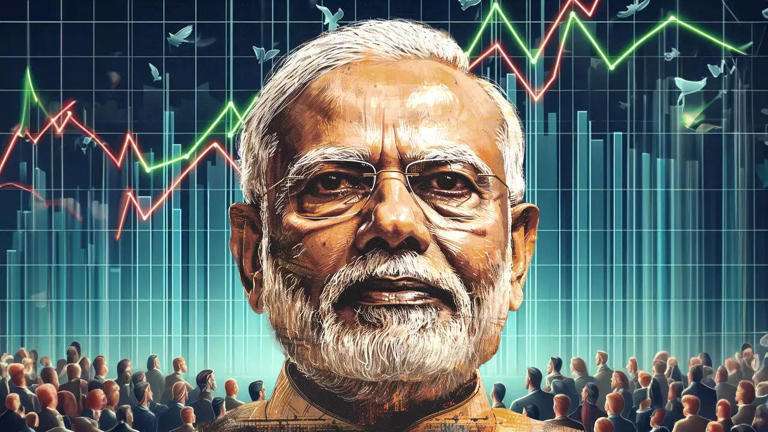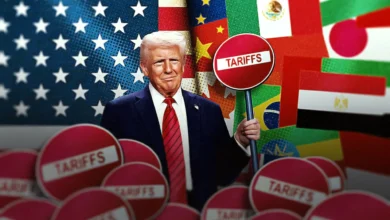What Has Mr. Modi And His NDA Govt Done For India’s Stock Markets And Indian Economy In the last 10 Years? Here Is The Story Of The Rise And Fall Of “Modi Stocks”

On June 4, the Indian stock market experienced a significant crash, triggered by the realization that Modi’s BJP would not secure a majority independently.
The result necessitated an NDA-led coalition, granting more influence to regional partners and strengthening the opposition.
What markets witnessed was the worst intraday fall in Indian stocks in four years, with foreign investors divesting approximately $1.5 billion worth of shares and domestic investors selling over Rs.3,300 crore.
As the market fluctuated between panic and cautious recovery, thankfully, by the end of that turbulent week, the market showed signs of recovery – key indices closed in the green, indicating a semblance of calm.
Given this backdrop and the major statement – markets will see “Magic” on June 4 (Modi’s claim and it did not), it becomes essential to evaluate the impact of policies introduced during the Modi regime on the stock market over the past decade.
 The Rise and Fall of “Modi Stocks”
The Rise and Fall of “Modi Stocks”
There is a particular subset of the stock market branded as “Modi stocks,” and needless to say over the next few months, these stocks will be closely monitored.
Capital markets and investment major CLSA has identified over 50 such stocks, including public sector companies like ONGC, BPCL, and SBI, as well as private firms like Reliance Industries, Adani Enterprises, and Adani Ports & SEZ.
These stocks initially surged following favourable exit poll indications but have since struggled with post-election results.
Presently, Indian stock markets are considered expensive, with valuations 12% higher than the 10-year averages, indicating a potential market correction.
Hence, this valuation excess must cool for more sustainable growth.
Now, to the critical question: What has the Modi government done in the last 10 years to bolster stock market growth?
Notably, there has not been a significant policy change aimed at strengthening stock market growth.
In fact, in 2018, then Finance Minister Arun Jaitley reintroduced the long-term capital gains tax on profits from the sale of listed equity shares exceeding Rs.1 lakh at a rate of 10% without offering any indexation benefits.
This move contrasted sharply with the policy under the United Progressive Alliance (UPA), where Finance Minister P. Chidambaram had exempted gains from the sale of equity shares or mutual funds held for over a year from any tax.
The latter approach arguably provided a more favourable environment for investors.
Now, going by the argument, market analysts voiced concerns about the effectiveness of a coalition government and noted that such arrangements can be unsettling for investors.
However, history reveals that coalition governments have, in fact, made significant economic strides in India.
Therefore, what are the examples that support the above statement – in July 1991, Prime Minister Narasimha Rao’s government initiated economic liberalization, dismantling the licence raj.
Similarly, the H.D. Deve Gowda-led coalition introduced a “dream budget” in 1997 with substantial tax cuts for corporates, foreign firms, and personal taxpayers, leading to remarkable growth in income tax collections—from Rs.18,700 crore in 1997 to over Rs.2 lakh crore in 2013.
The NDA-led governments have also contributed positively to economic development, with initiatives like the PM Gram Sadak Yojana for rural infrastructure, the Information Technology Act of 2000, and a focus on disinvestment.
Additionally, the UPA government’s introduction of the Mahatma Gandhi National Rural Employment Guarantee Act (MGNREGA) in 2006 has been pivotal, providing crucial employment to the rural poor and acting as a lifeline during post-COVID economic distress.
The above examples show that clear, compelling, and equitable economic policies have often emerged from coalition governments, emphasising the potential benefits of collaborative governance in addressing economic challenges.
 Broader Economic Reforms
Broader Economic Reforms
Looking at broader economic reforms, the road ahead appears challenging.
In the past decade, two major economic policies were rolled out by the Modi-led NDA government: the Goods and Services Tax (GST) and the Insolvency and Bankruptcy Code (IBC) of 2016.
However, despite their potential, both these reforms have faced significant criticism for inherent structural flaws that require addressing.
In May 2014, the Modi government promulgated an ordinance to amend the Right to Fair Compensation and Transparency in Land Acquisition, Rehabilitation, and Resettlement Act of 2013; the ordinance aimed to exempt certain categories of projects from the “consent” clause of the 2013 law.
However, widespread protests led to the government allowing the ordinance to lapse; similarly, three contentious farm laws met the same fate and were rolled back following substantial opposition.
Therefore, what are the immediate concerns for the Modi-led coalition govt?

1. Addressing Unemployment
The foremost priority for the incoming government (a must) is addressing the deepening unemployment crisis.
Public-sector employment alone cannot accommodate the growing number of people entering the job market; therefore, the government must implement measures to stimulate both manufacturing and private-sector employment.
2. Fiscal Management and Welfare Spending
The government has some fiscal breathing space, thanks to a significant Rs.2.11 trillion dividend from the Reserve Bank of India (RBI), which provides an opportunity to reduce the fiscal deficit and focus on sustained and targeted welfare capital expenditures.
Prudent fiscal management combined with strategic investments in infrastructure and social welfare programs can help stabilize the economy and support vulnerable populations.
3. Realistic Disinvestment Targets
For the fiscal year 2023-24, the government set a disinvestment target of Rs.51,000 crore, the lowest in seven years.
However, the government missed its disinvestment target for 2022-23, indicating a need for a more realistic approach.
While strategic sales of companies like BEML, Shipping Corporation of India, and IDBI Bank are reportedly at mature stages, actual execution remains crucial.
The disinvestment of LIC, for instance, left investors dissatisfied, with their investments taking a year and a half to turn positive due to high pricing.
 3. Climate Change And Environment Policies
3. Climate Change And Environment Policies
While addressing climate change and environmental sustainability has not been a priority for previous governments, this, however, has to change!
To give a perspective on this pressing concern, the Election Commission scheduled this year’s general election over a 40-day period of burning heat, which resulted in at least 33 people, including election officials on duty, dying of suspected heatstroke.
To understand the impact consider these figures – in the last 10 years of the Modi govt and by 2022, the number of forest, wildlife, coastal regulation zone, and environmental clearances the Modi government granted rose to a never-before-seen high of 12,496.
An unprecedented number of environmental clearances are raising concerns about the long-term impact on India’s natural resources and ecosystems.
The evidence of climate change is undeniable, with extreme weather events becoming more frequent and severe- the NDA government must prioritize sustainable development practices, balancing economic growth with environmental preservation.
5. Tackling Youth Unemployment
The alarming rate of youth unemployment poses a significant challenge to India’s socio-economic stability.
With young people constituting the majority of the unemployed, the government must prioritize job creation and skill development. Equally crucial is addressing the prevalence of poor-quality jobs in the informal sector.
Formalizing the workforce through labor reforms, ensuring fair wages, and improving working conditions can enhance job quality and economic security.
 6. Addressing Economic Inequality and Auditing Welfare Spending
6. Addressing Economic Inequality and Auditing Welfare Spending
While welfare schemes are essential for supporting vulnerable populations, their effectiveness must be critically evaluated because, despite numerous welfare programs, economic inequality in India has reached alarming levels.
A comprehensive audit of these schemes is necessary to assess their impact and identify gaps in coverage and implementation – these audits should focus on understanding who benefits from these schemes, the extent of their reach, and the reasons for persistent financial distress among households.
7. Restoring Faith In India’s Institutions
Arguably, the most significant ‘change’ that has come about is the erosion of trust in key institutions, damaging the foundation of democracy and economic stability.
Public confidence in the judiciary, Election Commission, market regulator, and enforcement agencies is crucial for maintaining law and order, fair governance, and market integrity.
Hence, restoring faith in these institutions requires strengthening their independence, ensuring transparency in their operations, and holding them accountable.
The government must lead by example, adhering to the principles of justice and fairness and rebuilding trust in institutions. This is essential for fostering a stable and thriving democracy and economy.
The Last Bit, the coming months, will require the coalition government to balance immediate market concerns with long-term structural reforms.
Addressing Unemployment, managing fiscal policies judiciously, and executing realistic disinvestment strategies will be equally critical.
As the market watches the performance of “Modi stocks” and broader economic indicators, the government’s ability to implement effective policies will be crucial in promoting sustainable growth and stability in India’s economy and for its people.




